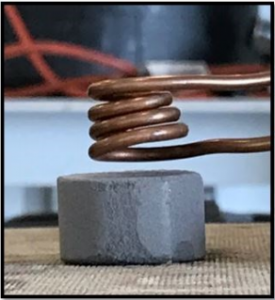Many things can cause defects in 3D printed parts, including the buildup of residual stress during the printing process. This can be caused by uneven thermal distribution. In a thesis entitled “Control of Thermal Distribution in Additive Manufacturing,” a University of Michigan student named Aniket Chandrashekhar Jadhav attempts to provide a cost-effective solution to uneven thermal distribution through the use of an induction coil to heat the powder, rather than heating the entire bed.

SEM images of balls formed at a fixed laser power of 300W but different scan speeds of (a) 0.05m/s, (b) 0.08m/s, and (c) 0.1m/s
“Controlling the thermal distribution in the powder bed becomes extremely crucial in terms of porosity control, formation of residual stresses, crack initiation, curling, balling and the overall build quality of the parts,” says Jadhav. “Also, significant enhancements in the material properties of the powder metal can be achieved by maintaining constant thermal cycles and temperature profiles throughout the process.”
 Research has been conducted into the introduction of induction coils along the edges of the powder bed to control the variation of temperature at different depths of the powder bed in order to achieve a gradual thermal gradiant during the 3D printing process. However, continues Jadhav, not much work has been put towards minimizing power consumption and optimizing thermal distribution at the same time with minimal modification in the powder bed setup, which is what the thesis project attempts to do.
Research has been conducted into the introduction of induction coils along the edges of the powder bed to control the variation of temperature at different depths of the powder bed in order to achieve a gradual thermal gradiant during the 3D printing process. However, continues Jadhav, not much work has been put towards minimizing power consumption and optimizing thermal distribution at the same time with minimal modification in the powder bed setup, which is what the thesis project attempts to do.
Jadhav and colleagues used simulation and actual physical trials to test their method of auxiliary heating the substrate to control the thermal distribution and selectively heat the powder. Flux concentrators were used on the induction coils to concentrate and channel the magnetic flux along the desired path and heat the substrate more quickly and effectively. They successfully tested different grades of steel and titanium.
“This ensured minimal changes in operational parameters to easily adapt to substrates with different material properties,” says Jadhav. “The proposed design of the induction coil is small enough to be a convenient addition to any complex environment for improved heating.”
 Jadhav suggests that there is a lot of room for improving and broadening the scope of the process, including using materials such as aluminum and copper. The simulations and data presented in the thesis are also limited to stationary heating of the substrate.
Jadhav suggests that there is a lot of room for improving and broadening the scope of the process, including using materials such as aluminum and copper. The simulations and data presented in the thesis are also limited to stationary heating of the substrate.
“Work still is in progress to study the effects of induction in translational motion and the required changes that will follow,” Jadhav explains. “These changes may be in terms of coil design modification or process optimization by fine tuning the parameters.”
Induction relies heavily on the coupling efficiency of the coil and substrate, Jadhav continues.
“This study provides good highlight over the improved magnetic flux density and a more contained magnetic field for substrate having a horizontal orientation. A detailed study of the effect of different orientations (e.g.: vertically orienting the substrate) on the coupling efficiency and thermal distribution would play an important role in applying the proposed technique to any Additive Manufacturing process.”
Jadhav also suggests trying different types of induction coils to optimize the process of induction and improve the efficiency of the system, with relatively lower power requirements.
Discuss this and other 3D printing topics at 3DPrintBoard.com or share your thoughts in the comments below.
Subscribe to Our Email Newsletter
Stay up-to-date on all the latest news from the 3D printing industry and receive information and offers from third party vendors.
You May Also Like
Why Corrosive Resistant Materials Are Important to the Success of 3D Printing Across Industries
The adoption of additive manufacturing (AM) is accelerating across many major industries. As this technological shift unfolds, the importance of corrosion resistance has emerged as a challenge for 3D printing...
America Makes Announces IMPACT 2.0: $6.6M in New 3D Printing Funding
America Makes, the Manufacturing Innovation Institute (MII) based in Youngstown, Ohio, has announced IMPACT (Improvement in Manufacturing Productivity via Additive Capabilities and Techno-Economic Analysis) 2.0, a project call which will...
3D Printing Webinar and Event Roundup: April 14, 2024
We’re starting off the week’s 3D printing webinars and events at ASTM AMCOE’s 11th Snapshot Workshop and MACH Exhibition. Stratasys continues its advanced training courses, SME is holding a virtual...
AMUK Welcomes Airframe Designs as British 3D Printing Industry Grows
While the UK is not the hub for 3D printer and materials manufacturers as other nations, the country continues to excel at the research, development, and application of additive manufacturing...































